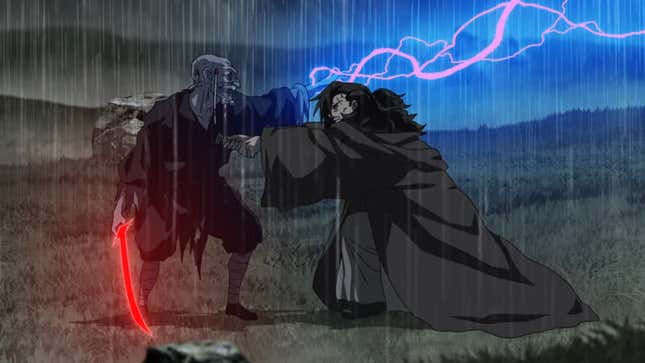Thought cortosis was the only thing with roots from Star Wars’ expanded universe that showed up on The Acolyte this week? Turns out, another old concept was hiding in plain sight… well, from a certain point of view.

Advertisement
Watching the Stranger, Mae’s sinister master, carve his way through the Jedi on Khofar in “Night” this week, you might have noticed that his unorthodox fighting style saw him constantly disengage and re-engage with his foes—a flurry of attacks, the deactivation of his lightsaber, only for it to repeat all over again. It’s just one of many duplicitous tools in the Stranger’s arsenal that we see throughout the episode, but not only is it a form of lightsaber combat largely unseen on-screen so far, it has its roots in the Expanded Universe. The official Star Wars website’s trivia breakdown for “Night” confirmed that the Stranger uses a form of lightsaber combat called tràkata—defined by its leverage of the lightsaber’s unique property as a melee weapon to be turned off and on during combat.
Advertisement
First introduced in John Whitman’s audio adaptation of Tom Veitch’s Dark Empire comic series in 1994, but not formally given its name until the final edition of Wizards of the Coasts’ Star Wars Roleplaying Game in 2007, tràkata was not a fully developed form of practiced lightsaber combat, but more of a philosophical technique that relied on using the ability to extinguish and re-ignite a lightsaber’s blade mid-combat to either deceive or execute your opponent. A practitioner of tràkata might briefly extinguish their blade to force their opponent to overcommit to an attack, or become unbalanced by the sudden change in force from exerting against another weapon, opening up their defenses—or suddenly ignite their blade to deliver an immediate, precision strike, such as placing the hilt of their saber to an opponent’s head or chest. Tràkata was frowned upon by Jedi and Sith alike: to the Jedi, it was ignoble to deceive your opponent in what was meant to be an honorable duel; to the Sith, the idea of a fighting style that de-emphasized the power and anger that fueled them was cowardly.
Advertisement

While The Acolyte marks the first time tràkata has been explicitly named in current Star Wars continuity, it’s not entirely the first time we’ve seen elements of the form in recent material. The Star Wars Visions first season episode “The Elder” sees a duel between a Jedi Master and a Sith climax with the former briefly extinguishing his blade, and moving his hilt over to the Sith’s chest, igniting it and mortally wounding him in an instant—and arguably a similar move is employed in The Last Jedi, when Kylo Ren catches a lightsaber tossed to him by Rey, quickly igniting and extinguishing the blade while the hilt was pointed at the head of a Praetorian guard restraining him. In Ahsoka’s fourth episode, “Fallen Jedi,” Inquisitor Marrok briefly disengages one of the blades of his double-bladed saber while Ahsoka is clashing against it, forcing her to lose balance momentarily.
Advertisement
The version of tràkata employed by the Stranger is a little different from these previous examples—choosing to disengage and re-engage from combat for longer periods of time than just quick extinguishing of his lightsaber—but it’s still cool to see another way The Acolyte is weaving elements from all over Star Wars’ history.
Want more io9 news? Check out when to expect the latest Marvel, Star Wars, and Star Trek releases, what’s next for the DC Universe on film and TV, and everything you need to know about the future of Doctor Who.
Services Marketplace – Listings, Bookings & Reviews